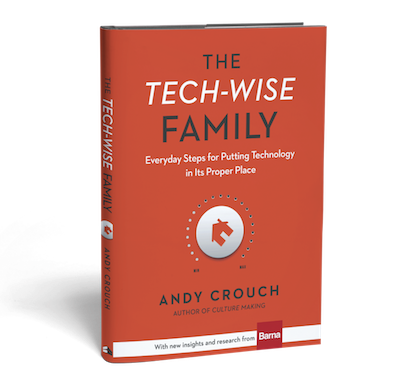Of the many things I suspect my children will both thank me for and spend years in therapy recovering from, the phrase proper place is probably near the top of the list.
On the spectrum from cleanness-obsessed neat freak to junk-tolerant compulsive hoarder, I’m definitely at the neatness end. So as soon as our children were old enough to understand the phrase, I started drilling into them the idea that at the end of each day, or at least once a week—OK, well, at least when friends were coming over—the flotsam and jetsam of our family life should all be put back in its “proper place.”
In a kind of demented version of musical chairs, we’d queue up ten minutes’ worth of music and target one part of our home. At the end of ten minutes, everything that was out of place needed to be put back or, if its proper place was in another part of the house, put in a laundry basket commandeered for that purpose. Anything that was not in its place or in the laundry basket by the time the music stopped was to be summarily thrown in the trash. In the last moments before the music stopped, out-of-place books, homework papers, and beloved stuffed animals would all dangle menacingly over the trash can, to be rescued (most of the time) by laughing—or shrieking—children.
My “proper place” game, like so much in parenting young children, walked a fine line between effective and ruthless. More cleanup got done in ten minutes of music-fueled, trashcan-threatened frenzy than in days of halfhearted reminders. And at the end, Dad got a clean house, the stuffed animals were safely back in the bedrooms, and the children were only slightly traumatized. Of course, I never made good on my threats to put anything of real value in the trash—though the difference between what I and my children considered “of real value” will no doubt be further material for those future therapy sessions.
But how do we find the proper place for technology in our family lives—and how do we keep it there? If only it were as simple as cleaning up a bunch of stuffed animals. Technology is literally everywhere in our homes—not only the devices in our pockets but the invisible electromagnetic waves that flood our homes. This change has come about overnight, in the blink of an eye in terms of human history and culture.
When previous generations confronted the perplexing challenges of parenting and family life, they could fall back on wisdom, or at least old wives’ tales, that had been handed down for generations. But the pace of technological change has surpassed anyone’s capacity to develop enough wisdom to handle it. We are stuffing our lives with technology’s new promises, with no clear sense of whether technology will help us keep the promises we’ve already made.
That sense of overwhelmed uncertainty applies to me and to my own family. I can’t possibly tell you how to handle the new app that your fifteen-year-old will want to install on her phone next week. I don’t even know, honestly, how to handle all the technology my family and I already have (and I’m a certified geek who has loved technology ever since my dad brought home a “computer terminal” and modem in the 1970s—kids, ask your grandparents what those were).
But I do know this: if we don’t learn to put technology, in all its forms, in its proper place, we will miss out on many of the best parts of life in a family. I’ve had the incredible, perplexing, and rewarding joy of parenting two children through the teenage years with my wife, Catherine—who is, by the way, a scientist who builds extraordinary technology in her lab and yet is incredibly sane in her lack of obsession with technology at home. As our children leave high school, we realize how much of the joy that we’ve experienced along the way, and know today, has come from the radical choices and commitments we made to keep technology in its proper place.
We haven’t always made the right choices, and it hasn’t always been easy. Some of what I share in my book, The Tech-wise Family, comes from friends and mentors who had much more insight than we did, and much more courage. A lot of it is informed by our Christian faith, which gives us the clearest way we know of understanding who we really are and who, by grace, we are meant to be. What it all adds up to is a set of nudges, disciplines, and choices that can keep technology in its proper place—leaving room for the hard and beautiful work of becoming wise and courageous people together. Indeed, becoming wise and courageous is what family is really about.
The proper place for technology won’t be exactly the same for every family, and it is not the same at every season of our lives. One of my happy memories from my early twenties is of watching Star Trek: The Next Generation every Tuesday night with my roommate, Steve, cracking jokes at the plot twists and fighting over the chunks of cookie dough in the quart of Ben & Jerry’s ice cream we consumed during the show each week. Twenty-five years later, given my other priorities, cotton-candy entertainment like Star Trek doesn’t have a proper place in my weekly schedule—and a weekly half quart of premium ice cream definitely doesn’t have a place in my waistline! In my twenties I could consume both, happily, and not have them interfere with my core callings and commitments.
So figuring out the proper place for technology in our particular family and stage of life requires discernment rather than a simple formula. Even the ten commitments in my book, The Tech-wise Family, are meant to be starting points for discussion—they are ones my own family has kept fitfully at best. But almost anything is better than letting technology overwhelm us with its default settings, taking over our lives and stunting our growth in the ways that really matter.
And I think there are some things that are true at every stage of life. Here are 6 ways to know when technology is in its proper place:
1) Technology is in its proper place when it helps us bond with the real people we have been given to love. It’s out of its proper place when we end up bonding with people at a distance, like celebrities, whom we will never meet.
2) Technology is in its proper place when it starts great conversations. It’s out of its proper place when it prevents us from talking with and listening to one another.
3) Technology is in its proper place when it helps us take care of the fragile bodies we inhabit. It’s out of its proper place when it promises to help us escape the limits and vulnerabilities of those bodies altogether.
4) Technology is in its proper place when it helps us acquire skill and mastery of domains that are the glory of human culture (sports, music, the arts, cooking, writing, accounting; the list could go on and on). When we let technology replace the development of skill with passive consumption, something has gone wrong.
5) Technology is in its proper place when it helps us cultivate awe for the created world we are part of and responsible for stewarding (our family spent some joyful and awe-filled hours when our children were in middle school watching the beautifully produced BBC series Planet Earth). It’s out of its proper place when it keeps us from engaging the wild and wonderful natural world with all our senses.
6) Technology is in its proper place only when we use it with intention and care. If there’s one thing I’ve discovered about technology, it’s that it doesn’t stay in its proper place on its own; much like my children’s toys and stuffed creatures and minor treasures, it finds its way underfoot all over the house and all over our lives. If we aren’t intentional and careful, we’ll end up with a quite extraordinary mess.
Excerpt adapted from The Tech-Wise Family by Andy Crouch. Copyright 2017. Baker Books, a division of Baker Publishing Group. All rights reserved. www.BakerPublishingGroup.com
***************
 Making conscientious choices about technology in our families is more than just using internet filters and determining screen time limits for our children. It’s about developing wisdom, character, and courage in the way we use digital media rather than accepting technology’s promises of ease, instant gratification, and the world’s knowledge at our fingertips. And it’s definitely not just about the kids.
Making conscientious choices about technology in our families is more than just using internet filters and determining screen time limits for our children. It’s about developing wisdom, character, and courage in the way we use digital media rather than accepting technology’s promises of ease, instant gratification, and the world’s knowledge at our fingertips. And it’s definitely not just about the kids.
Drawing on in-depth original research from the Barna Group, Andy Crouch shows readers that the choices we make about technology have consequences we may never have considered. He takes readers beyond the typical questions of what, where, and when and instead challenges them to answer provocative questions like, Who do we want to be as a family? and How does our use of a particular technology move us closer or farther away from that goal? Anyone who has felt their family relationships suffer or their time slip away amid technology’s distractions will find in this book a path forward to reclaiming their real life in a world of devices.
